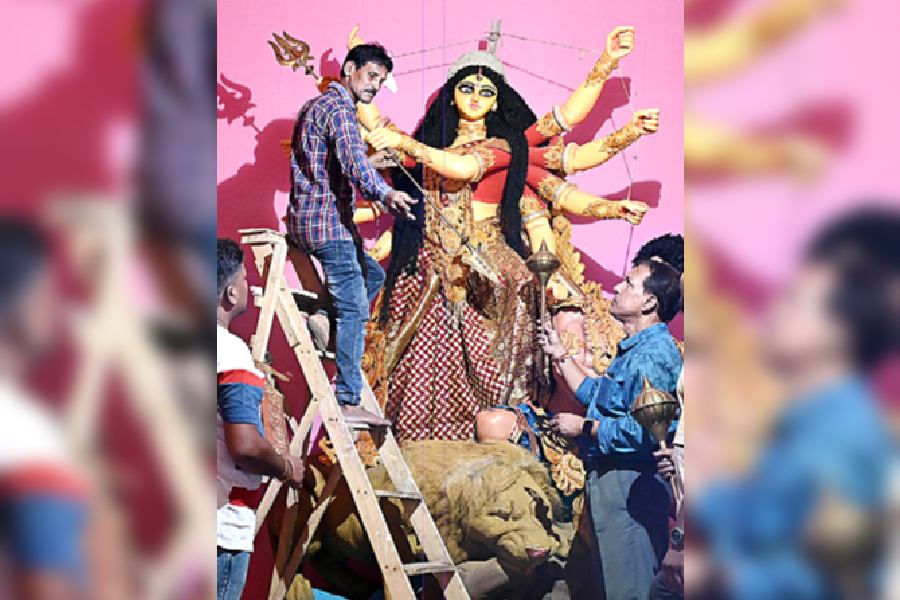A Durga Puja and Id namaz happen in the same park in Mominpore.
The puja turns 50 this year. When Metro visited Hossain Shah Park — a five-minute drive from Diamond Harbour Road — on Tuesday afternoon, finishing touches were being given to the pandal and the idols.
Perched on a ladder, a man was placing weapons in the hands of the goddess. Muhammed Syed, a resident of the area, has been doing this for more than 20 years. He is 38 now.
“Bolar moto aar kichhu noy. Eta proti bochhor kori. Bhalo laage. Obhyash hoye gachhe (I don’t think this is something worth mentioning. I do this every year. It has become a habit),” Syed, a decorator by profession, told this newspaper.
The man passing the weapons to Syed was Satinath Adhya, another crucial hand in the puja.
Mominpore Tarun Sangha mirrors how Durga Puja is more than a religious festival in blurring the differences of religion, caste and language.

Shah Alam (second from left) with Chayan Kumar Bhowmik (extreme right) at the Park Street Palli Sarbojonin puja on Ripon Street on Tuesday. Bhowmik is secretary of the puja committee, while Alam is an active participant.
“This is a predominantly Muslim neighbourhood. Muslim families are the mainstay of this Durga Puja, which is celebrating its golden jubilee. The same ground is the venue for Id prayers and Christmas celebrations,” said Arunabha Mukherjee, a local builder and one of the organisers.
Chetla Agrani, one of the big-ticket pujas in the city, takes place on a ground that has a mosque standing on it. “Living together is ingrained in our culture,” said an organiser of Chetla Agrani.
Calcutta is replete with examples of similar pujas. Not many of them can match Agrani in scale and grandeur but the same spirit of inclusiveness drives these community pujas.
The Park Street Palli Sarbojonin Durogotsab Committee’s puja on Ripon Street turns 76 this year. On Tuesday evening, Shah Alam, 67, was turning the leaves of the subscription booklet when this newspaper visited the pandal.
The idol is supposed to reach the pandal on Wednesday. Alam was discussing the logistics of bringing the idol from Kumartuli with Chayan Kumar Bhowmik, secretary of the puja.
“I was born and raised here. All my life, I have known this as parar puja. This time of the year, I spend more time in the pandal than I do at my home,” said Alam, a third-generation resident in the neighbourhood, dotted with homes and shops, most of them with Muslim names.
An elaborate bhog spread on Ashtami draws a big crowd. Alam and Md Khaled, 69, another resident of the locality, supervise the distribution of prasad.
The Lohapatti Durga Puja, on AJC Bose Road, near the Nonapukur tram depot, is an assimilation of Hindus, Muslims and Anglo-Indian Christians. “This neighbourhood is like a mini-India. The puja is just a reflection of that,” said Shamshad Alam, joint secretary of the puja committee.
Most of the puja organisers this newspaper spoke to suggested that the spirit of togetherness was nothing special. But it stands out in the backdrop of the communal polarisation that has reared its ugly head across the country.
“Inclusiveness is ingrained in Indian culture. But the past decade has witnessed a full-fledged attack on this culture. That is why we should preserve it,” said Abul Kashim Molla, a doctor, president of the Mominpore Tarun Sangha puja and a former Trinamul MLA.
Durga Puja is also a testament to a collaboration between Hindus and Muslims, which exemplifies yukta sadhana that Nobel laureate Amartya Sen keeps harping on to keep communal forces at bay. Kshitimohan Sen, his maternal grandfather, was the foremost proponent of the concept of yukta sadhana.
Last year, Unesco’s included Calcutta’s Durga Puja on the list of “intangible cultural heritage”.
Art historian Tapati Guha Thakurta, who led a team that prepared the dossier that won the Unesco tag for Durga Puja, said inclusivity was evident in the artisanal, creative and administrative personnel associated with the Puja.
“Muslim artisans have been working in the field for a very long time. In terms of the artisanal and occupational groups, you could find low castes. Even within the puja designers, they certainly don’t come from the upper classes or upper castes.... All of these support the claim that the festival has gone beyond its pure religiosity. But the inner community of worship remain part of the Hindu community,” she said.
“The inclusivity of diverse religious and caste groups in the artisanal labour, creative personnel, organisational authorities and the crowds of spectators were emphaised in the Unesco dossier,” she said.
